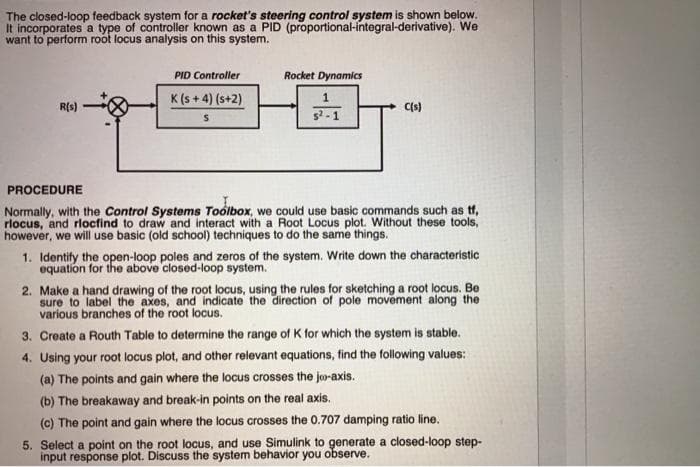The closed-loop feedback system for a rocket's steering control system is shown below. It incorporates a type of controller known as a PID (proportional-integral-derivative). We want to perform root locus analysis on this system. PID Controller Rocket Dynamics K (s + 4) (s+2) R(s) Cs) s2-1 PROCEDURE Normally, with the Control Systems Toolbox, we could use basic commands such as tf, rlocus, and rlocfind to draw and interact with a Root Locus plot. Without these tools, however, we will use basic (old school) techniques to do the same things. 1. Identify the open-loop poles and zeros of the system. Write down the characteristic equation for the above closed-loop system. 2. Make a hand drawing of the root locus, using the rules for sketching a root locus. Be sure to label the axes, and indicate the direction of pole movement along the various branches of the root locus. 3. Create a Routh Table to determine the range of K for which the system is stable.
The closed-loop feedback system for a rocket's steering control system is shown below. It incorporates a type of controller known as a PID (proportional-integral-derivative). We want to perform root locus analysis on this system. PID Controller Rocket Dynamics K (s + 4) (s+2) R(s) Cs) s2-1 PROCEDURE Normally, with the Control Systems Toolbox, we could use basic commands such as tf, rlocus, and rlocfind to draw and interact with a Root Locus plot. Without these tools, however, we will use basic (old school) techniques to do the same things. 1. Identify the open-loop poles and zeros of the system. Write down the characteristic equation for the above closed-loop system. 2. Make a hand drawing of the root locus, using the rules for sketching a root locus. Be sure to label the axes, and indicate the direction of pole movement along the various branches of the root locus. 3. Create a Routh Table to determine the range of K for which the system is stable.
Introductory Circuit Analysis (13th Edition)
13th Edition
ISBN:9780133923605
Author:Robert L. Boylestad
Publisher:Robert L. Boylestad
Chapter1: Introduction
Section: Chapter Questions
Problem 1P: Visit your local library (at school or home) and describe the extent to which it provides literature...
Related questions
Question

Transcribed Image Text:The closed-loop feedback system for a rocket's steering control system is shown below.
It incorporates a type of controller known as a PID (proportional-integral-derivative). We
want to perform root locus analysis on this system.
PID Controller
Rocket Dynamics
K (s + 4) (s+2)
8.
R(s)
Cs)
s2-1
PROCEDURE
Normally, with the Control Systems Toolbox, we could use basic commands such as tf,
rlocus, and rlocfind to draw and interact with a Root Locus plot. Without these tools,
however, we will use basic (old school) techniques to do the same things.
1. Identify the open-loop poles and zeros of the system. Write down the characteristic
equation for the above closed-loop system.
2. Make a hand drawing of the root locus, using the rules for sketching a root locus. Be
sure to label the axes, and indicate the direction of pole movement along the
various branches of the root locus.
3. Create a Routh Table to determine the range of K for which the system is stable.
4. Using your root locus plot, and other relevant equations, find the following values:
(a) The points and gain where the locus crosses the jo-axis.
(b) The breakaway and break-in points on the real axis.
(c) The point and gain where the locus crosses the 0.707 damping ratio line.
5. Select a point on the root locus, and use Simulink to generate a closed-loop step-
input response plot. Discuss the system behavior you observe.
Expert Solution
This question has been solved!
Explore an expertly crafted, step-by-step solution for a thorough understanding of key concepts.
This is a popular solution!
Trending now
This is a popular solution!
Step by step
Solved in 4 steps with 4 images

Knowledge Booster
Learn more about
Need a deep-dive on the concept behind this application? Look no further. Learn more about this topic, electrical-engineering and related others by exploring similar questions and additional content below.Recommended textbooks for you

Introductory Circuit Analysis (13th Edition)
Electrical Engineering
ISBN:
9780133923605
Author:
Robert L. Boylestad
Publisher:
PEARSON

Delmar's Standard Textbook Of Electricity
Electrical Engineering
ISBN:
9781337900348
Author:
Stephen L. Herman
Publisher:
Cengage Learning

Programmable Logic Controllers
Electrical Engineering
ISBN:
9780073373843
Author:
Frank D. Petruzella
Publisher:
McGraw-Hill Education

Introductory Circuit Analysis (13th Edition)
Electrical Engineering
ISBN:
9780133923605
Author:
Robert L. Boylestad
Publisher:
PEARSON

Delmar's Standard Textbook Of Electricity
Electrical Engineering
ISBN:
9781337900348
Author:
Stephen L. Herman
Publisher:
Cengage Learning

Programmable Logic Controllers
Electrical Engineering
ISBN:
9780073373843
Author:
Frank D. Petruzella
Publisher:
McGraw-Hill Education

Fundamentals of Electric Circuits
Electrical Engineering
ISBN:
9780078028229
Author:
Charles K Alexander, Matthew Sadiku
Publisher:
McGraw-Hill Education

Electric Circuits. (11th Edition)
Electrical Engineering
ISBN:
9780134746968
Author:
James W. Nilsson, Susan Riedel
Publisher:
PEARSON

Engineering Electromagnetics
Electrical Engineering
ISBN:
9780078028151
Author:
Hayt, William H. (william Hart), Jr, BUCK, John A.
Publisher:
Mcgraw-hill Education,